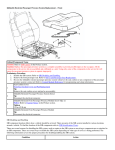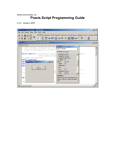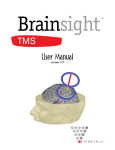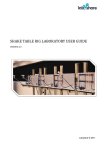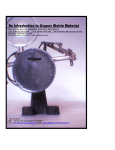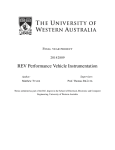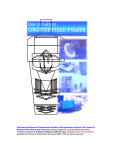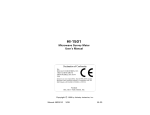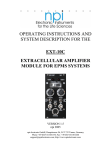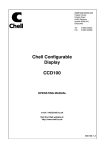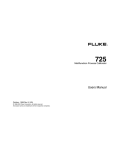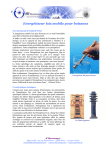Download Warranty Experimental Life Energy Meter
Transcript
Warranty Heliognosis’ Experimental Life Field Meters are warranted against defects of materials and workmanship, excluding abuse or misuse, for a period of one year from the date of purchase. Heliognosis, at its option, will either repair or replace it with a unit of equivalent quality. Probes for the Life Meter are not covered by this warranty. In order to obtain service under this warranty, the customer must contact Heliognosis or an authorized dealer prior to the end of the warranty period. The customer is responsible for prepaid shipping to Heliognosis or its authorized dealer and must furnish proof of purchase which specifies the date of purchase. Heliognosis will pay return shipping charges within North America only. This warranty is given by Heliognosis in lieu of any other warranties, express or implied. Heliognosis disclaims any implied warranties of merchantability or fitness for a particular purpose. Heliognosis shall not be liable for loss of use of the meter or other incidental or consequential damages, expenses or economic loss, or for any claim or claims for such damage, expenses or economic loss. Copyright Heliognosis 2013. All rights reserved. These devices are FCC exempt and comply with part 15.103(h) of the FCC regulations. These devices are ROHS and CE compliant. “This device complies with part 15 of the FCC rules. Operation is subject to the following two conditions: (1) This device must not cause harmful interference, and (2) This device must accept any interference received, including interference that may cause undesired operation.” Experimental Life Energy Meter In 1947, Wilhelm Reich MD published The Cancer Biopathy, detailing his research in visualizing and applying “Orgone Energy”. In this work, he described a device which he called the “Orgone Field Meter” which responded to living things as they were brought close to the device. The Experimental Life Energy Meter, developed by Heliognosis, is based on the same principle as Reich’s device and has been made into a small bench-top unit. This device is useful for many applications in the scientific and health fields because of its high sensitivity and broad range. Five ranges are provided to span from the strongest life field down to the minute fluctuations of space itself. The x1 range is intended for measuring relative comparisons of living, organic and inorganic samples from humans and animals to plants and solutions. The user can then zoom in to make accurate measurements using the x10 and x100 ranges. The zero point is continuously adjustable to allow both relative percent and +/- readings making comparisons between different samples a breeze. The x1k range allows for the detection of very weak or distant fields with stability. The x2k range is intended for monitoring the aethereal fluctuations in the surrounding space of the sensor. The meter is provided with a built-in small flat plate electrode located under the blue square above the meter. This internal electrode may be used for measuring liquid containers and small objects by conveniently placing the test object on the center of the blue square. Humans, animals and plants may also be measured by bringing them in contact with the blue square. Alternatively, a tube electrode included in the package may also be used by plugging it into the red connector on the top of the unit. This electrode is convenient for grasping with the hand or immersing into liquids. An optional 2 sq ft plate is available which may be employed for greater sensitivity. Objects may be placed directly on the plate for comparison measurements. Human fields will be detected up to 2 ft using the tube or small plate and 6ft using the large plate. A selector switch on the top face of the unit should be placed in the “small” position for the tube sensor and the small plate. If you wish to use a large plate of approx. 2 sq. ft, use the “large plate” position. Experimenters may connect their own sensors or plates using a standard banana cable. Please note that sensitivity of the device is proportional to plate area. Plate areas substantially different from those listed above may fall out of the useful range of the device. Their are no standards for the measurement of life fields, and so the device is calibrated in percent units of full scale. A few of the possible applications of this unique device are listed below: - measurement of the overall health of an individual - testing of water samples -analysis of food products for relative energetic content -study of plants and prediction of nutrient requirements -comparison of liquid solutions for health benefits -scientific research into life processes -testing of alternate energy devices for unconventional energy fields -experimentation with Orgone accumulators and blankets The Life energy meter contains a low frequency electric field which is coupled unipolarly through an AC current sensor to the probe. The probe emits a weak “displacement current” field into the surrounding space. The more that this energy field is absorbed, the higher is the reading on the meter. Reich discovered that this absorption is stronger in living things than in non-living things. Water and metal also yield high readings. Many tests have revealed that this meter is insensitive to electromagnetic, magnetic, nuclear and electrostatic fields. Please note that the energy from the probe is harmless and very weak. Direct contact with the skin will not cause any unpleasant sensations. Operating instructions: Place the unit on a flat surface away from electrical wiring, metallic objects and large bodies of water. If you are using the internal electrode, make sure the toggle switch on the top of the unit is in the “small” position. If you are using the tube electrode, attach the probe to the red probe connector on the top of the device. The toggle switch is also in the small position for the tube electrode. Rotate the range selector switch on the front face of the meter to the “x1” position. Adjust the “coarse” zero control until the meter needle rests just above “0” on the meter scale ( or alternatively, for +/- readings, set the needle to the center of the meter scale). The “fine” zero control may be used to make smaller adjustments. Touch the blue square with the hand and observe the needle deflection. To increase the sensitivity and sensing distance, simply switch to the next highest range and re-adjust the zero controls to place the needle in the desired starting position. To measure small differences between subjects, switch to the next highest range while scanning your reference subject and adjust the zero to mid-scale (50%). Next, observe the test subject and note the difference. For accurate measurements, and for use of the x100, x1k and x2k ranges, it is preferable that the unit “warm up” for at least 5 minutes. In the first few minutes of operation, the readings may vary a little on the highest ranges until it reaches equilibrium. Thereafter, temperature changes around the sensor may cause the plate to increase or decrease in surface area due to thermal expansion associated with all materials. These changes in plate area will be observable on the highest ranges. In order to prevent this, make accurate measurements under stable temperature conditions. When adjusting the controls, your body field may influence the readings. Make an adjustment and then move away to see where the needle rests. The meter will typically deflect 50% on the x1 range when the flattened hand is in contact with the “blue square” electrode. Small solutions and plants will deflect approximately 10% on the x1 range and may be better observed on the x10 range. The hand and body may be detected over 12 inches on the x100 and x1k ranges. A 2 sq ft plate will extend this range up to 6 ft. The local Orgone atmospheric field will cause fluctuations which will be visible on the x1k and x2k ranges and appear in the VLF spectrum below 10Hz. The recorder output may be employed to track these fluctuations in addition to subject data. The recorder output is 0 - 8V, 1/8” mono phone jack on the front face of the unit labeled “out”.. Battery replacement: The LM4 comes with 4 “AA” batteries ready to use. When the “low battery” light stays on with a red glow, it is time to replace the batteries. Grasp the rubber boot cover at the bottom of the unit and pull it off towards the back. Once the boot is off, find the battery compartment as shown in the above picture. Slide off the cover, take out the batteries and replace them with a fresh set. The meter may be stood on a 45 degree angle using the built-in stand. This position is convenient to observe the meter from a sitting position when operated on a table. The meter is shown above with the stand extended. If you are using the “Out” jack, keep the lead in wires away from the test subject since they may influence the reading. The “Out” jack is a mono 1/8” phone jack with a -1.5 to +3.5V output. This analog voltage output will follow the meter motion. The output jack can be connected to a data acquisition system such as the Labjack U3, a chart recorder or an oscilloscope. Example 1 Example 2 The first example involves a series of leaves from an apple tree. To set up the experiment, use the internal electrode and place the rear switch to the “small plate” position. Turn on the meter and switch the range to “x10”. After a minute or so of warm up, zero the meter so that the needle sits exactly over “0%”. A healthy leaf is picked from an apple tree and placed as flat as possible and centered on the blue square above the meter.. The first reading is recorded as 18. Care is taken to keep our body field away from the plate and knobs of the life meter to prevent energetic influence during the measurement. The first leaf is removed and the meter is checked to insure that it returns to zero, If some deviation from zero has occurred, the meter is re-zeroed and the first leaf is re-tested. A second sick leaf of similar size and weight is then placed on the plate. In this case the leaf has a few small holes and blotchy blackened patches. This second leaf is measured and recorded. The leaf is removed from the plate and again the zero is re-checked. Next, a yellow live leaf without any apparent disease is measured. Finally a dead brown and shrivelling leaf is tested. The results are as shown below: All leaves were approximately 4 square inches of surface per side. A large plate of 320 square inches is connected by a lead wire to the top red connector. The switch on the top is moved to the “large” setting. The large plate is insulated from the ground using a 0.75 inch thick piece of styrofoam. On top of the internal metal plate is a 1/64th inch thick vinyl sheet. The range switch is turned to x100 and then a 11 year old child is asked to stand on the plate assembly. The zero control is adjusted to read “50%” for the child. Next, two adults each stand on the plate and their readings are taken. Finally, three plastic gas containers filled with tap water are placed on the plate and measured. The results are as shown below: Subject Child 11yrs Female 44 yrs Male 51 yrs Water reading(x100) weight 50 90 78 6 90 lbs 162 lbs 162 lbs 160 lbs Example 3 Leaf healthy sick yellow brown reading(x10) 11 4 7 1 weight 0.3g 0.3g 0.3g 0.2g The “blue square” electrode is connected in the usual way and the scale is adjusted to the “x100” range. Small 10mL glass vials with lids are filled with 10mL of the following liquids: Bottled spring water (Luso), tap water, black tea, milk and orange juice (not from concentrate). The scale is zeroed using the Luso bottled water sample. Each sample is then placed in sequence on the middle of the blue square and the readings are recorded. Sample reading (x100) Luso water tap water black tea milk Orange juice 0 5 13 41 63 volume 10mL 10mL 10mL 10mL 10mL Example 4 The tube electrode is placed in the probe socket and the range switch is set to “x1”. The needle is adjusted to sit on “zero” and the hand is wrapped around the glass part of the tube so that it is completely surrounded. A reading is recorded from the meter. Next, the range switch is increased to “x10” and re-zeroed. The palm of the hand is brought to within 3/8” of the tube and a reading is taken. The range switch is then increased to “x100” and after re-zeroing, the palm of the hand is approached to the tube to a distance of 2.5”. A reading is taken and recorded. The range switch is further increased to “x1k” and rezeroed. The palm of the hand is held at 4” and a reading is recorded. Finally with the range switch at x2k, the zero is carefully adjusted to approximately zero. Within the background fluctuations, the influence of the hand can be seen at a distance of over 1 ft. The data from this human energy field test is as shown below: Range reading distance x1 x10 x100 x1k x2k 25% 30% 30% 30% 30% touching 3/8” 2.5” 4” 7” Selected Experimental Data How to connect and select the probes: The LM4 Experimental Life Energy Meter comes with a built in square flat plate electrode electrode. A tube electrode, external small flat plate or large plate electrode may also be used. The gold plug of these electrodes must be plugged in to the red connector when they are used. Also, the selector switch must be set in the appropriate position for proper operation. Please refer to the below diagram. The toggle switch has three positions . To the left is the “small” position for the built in electrode, the tube electrode and the external small flat plate electrode. For the large plate electrode, move the toggle switch to the right to the “large” position. The “Hybrid” centre position of the toggle switch is used with the Fluid probe accessory. The Fluid probe has a black connector and a red connector. The black goes to the black “Ext” connector and the red goes to the red “Probe” connector. The large plate should be isolated from the floor using low density foam or a wood stand. The large plate is best used in the x10, x100 or x1000 range to get the optimum sensitivity.






